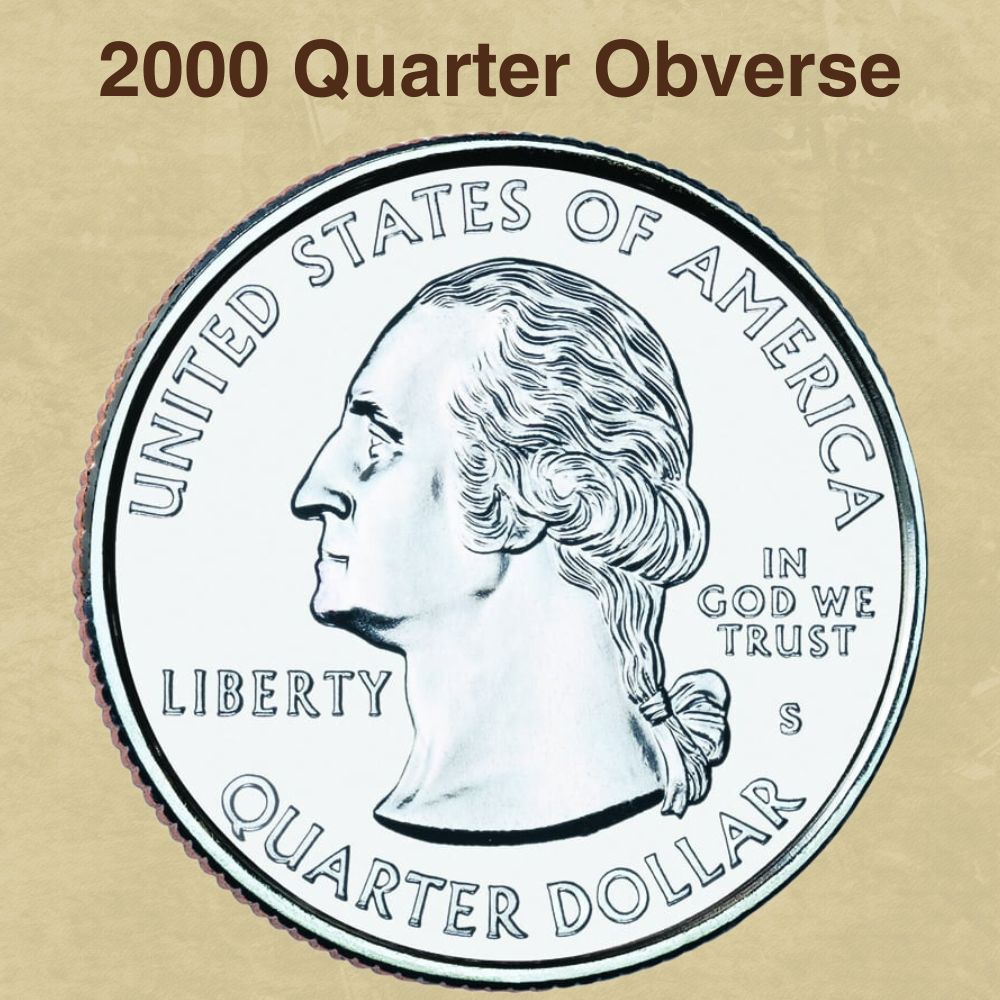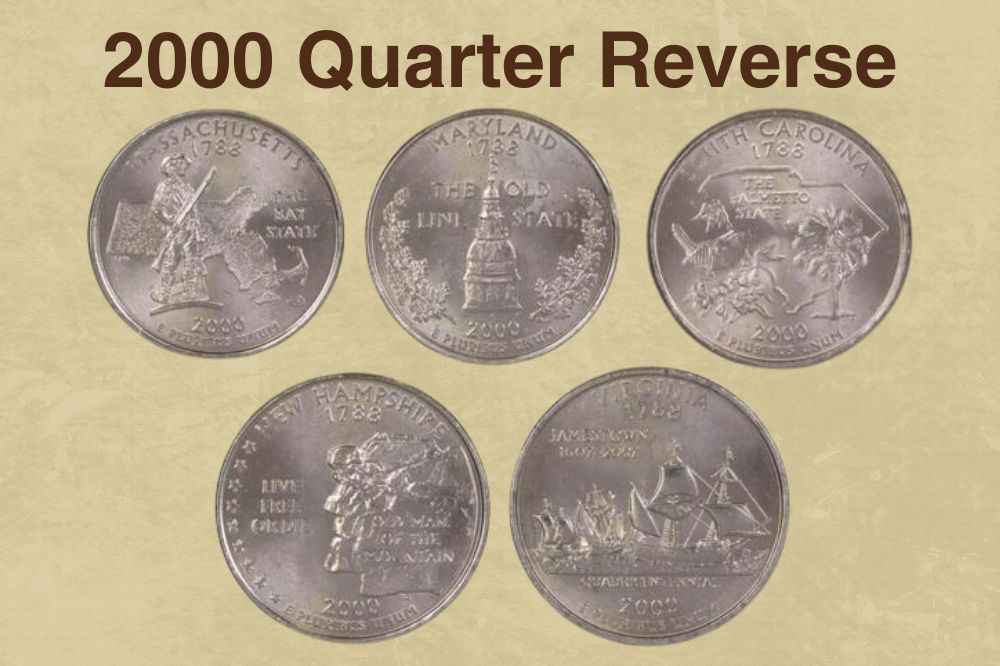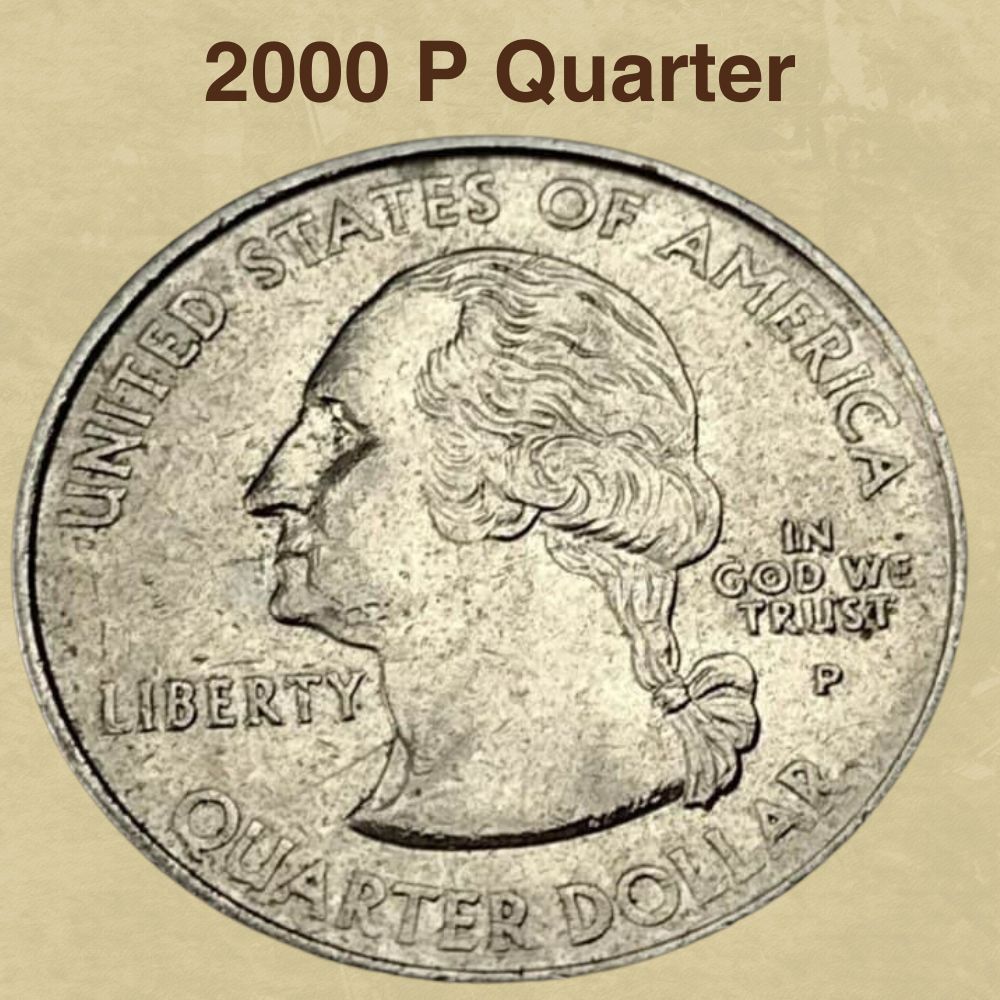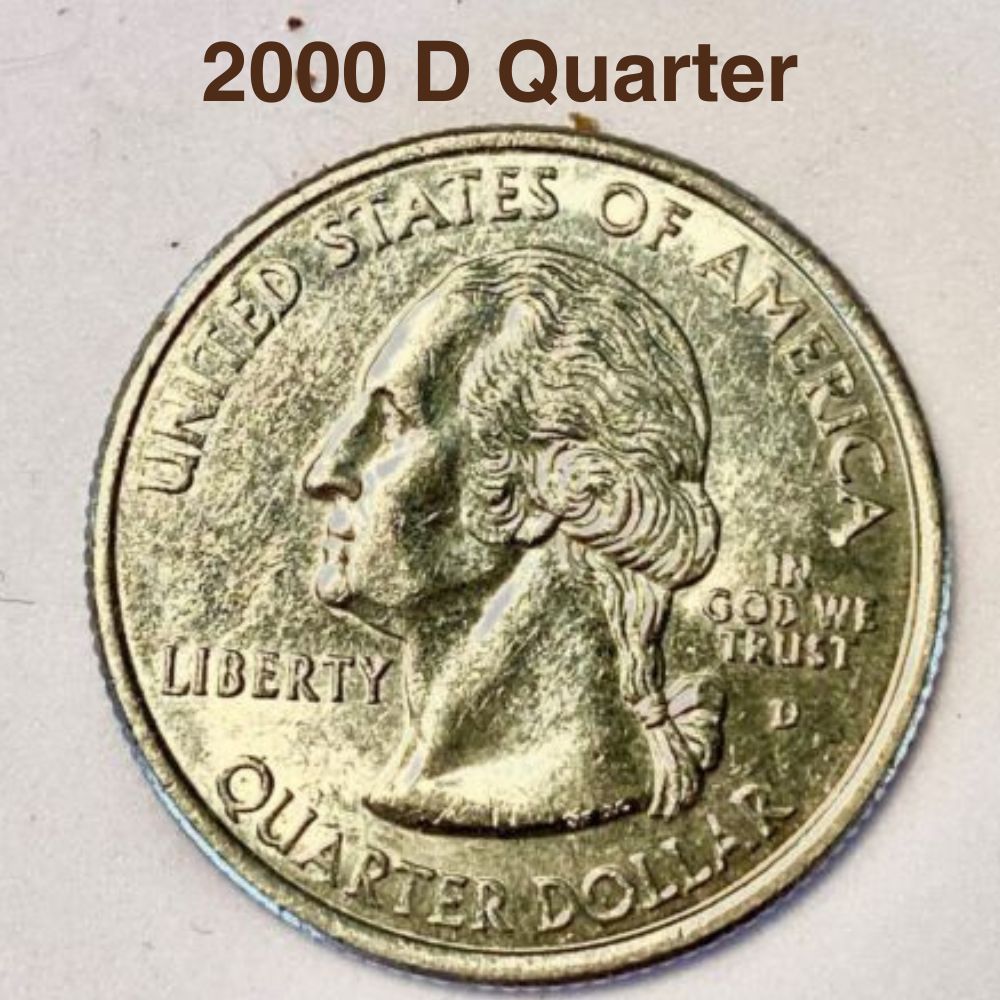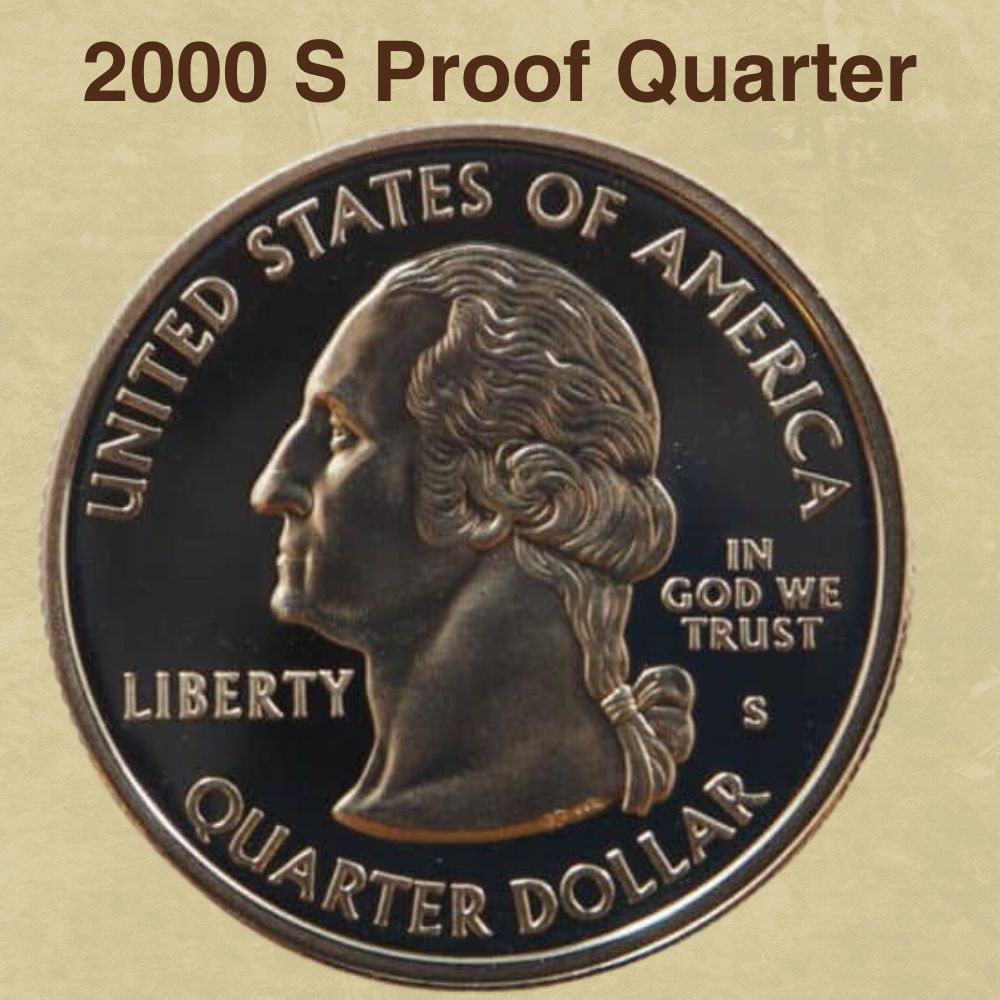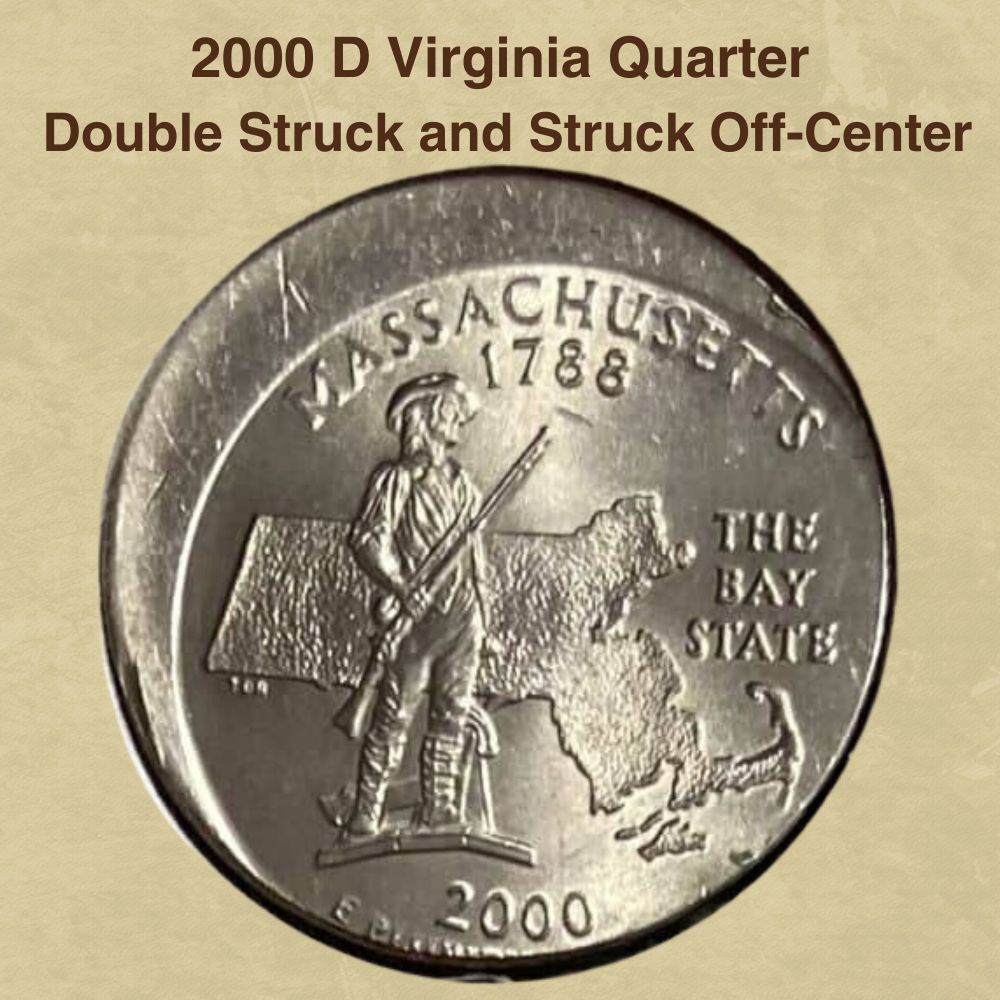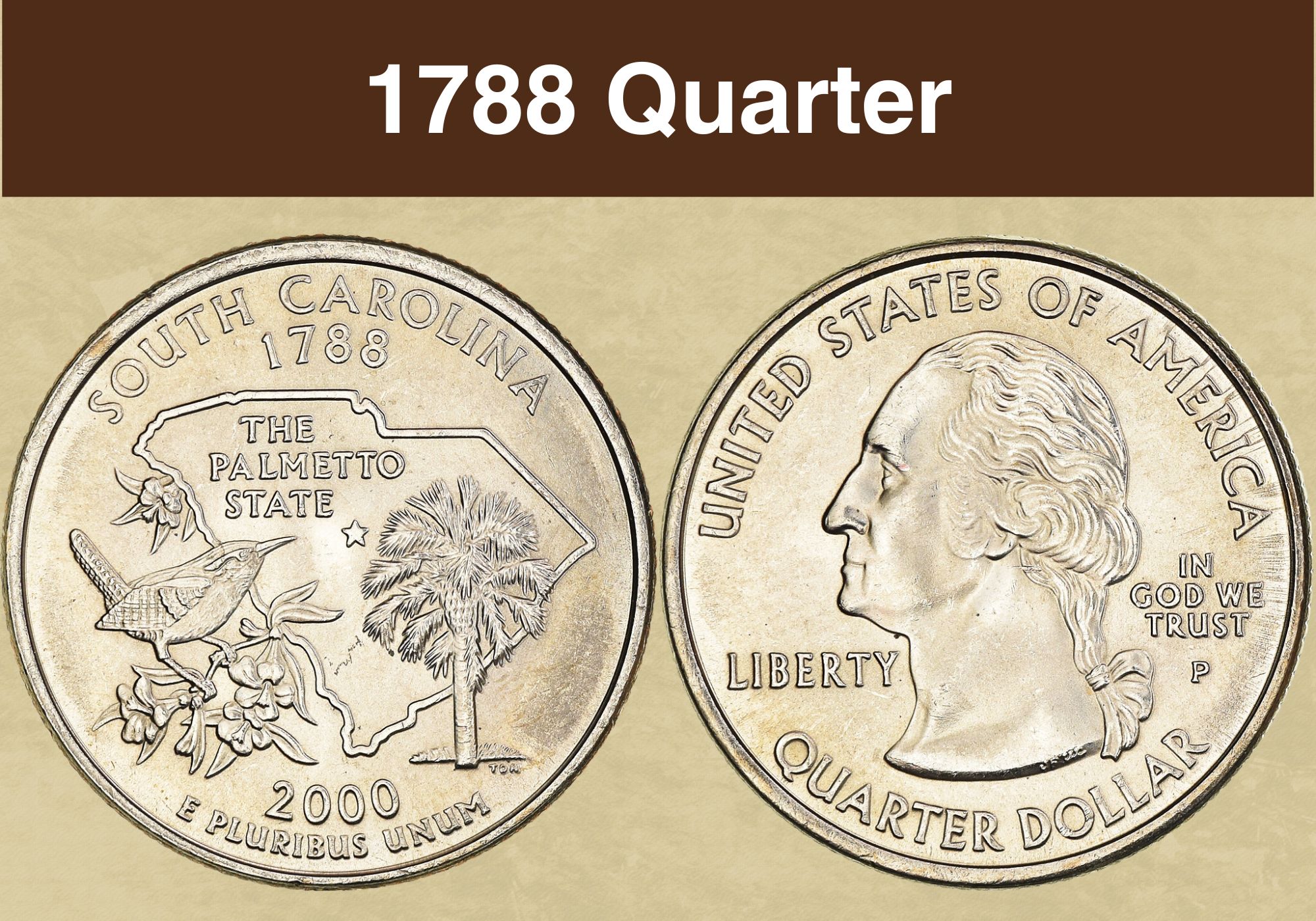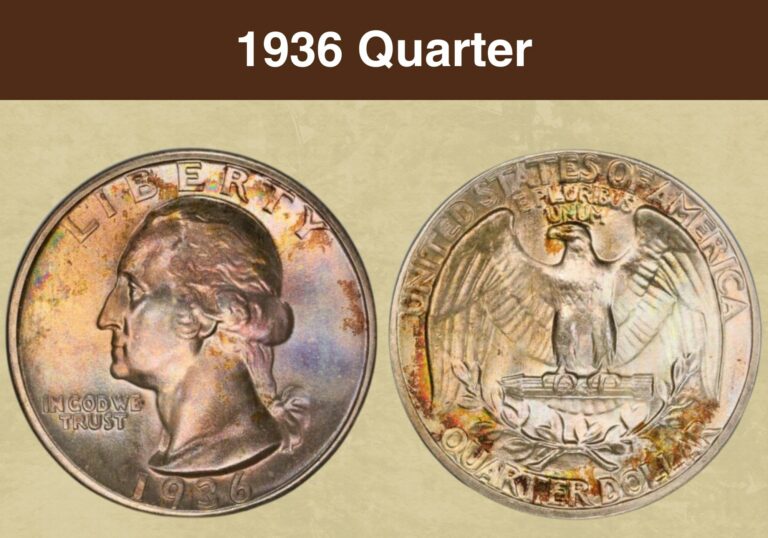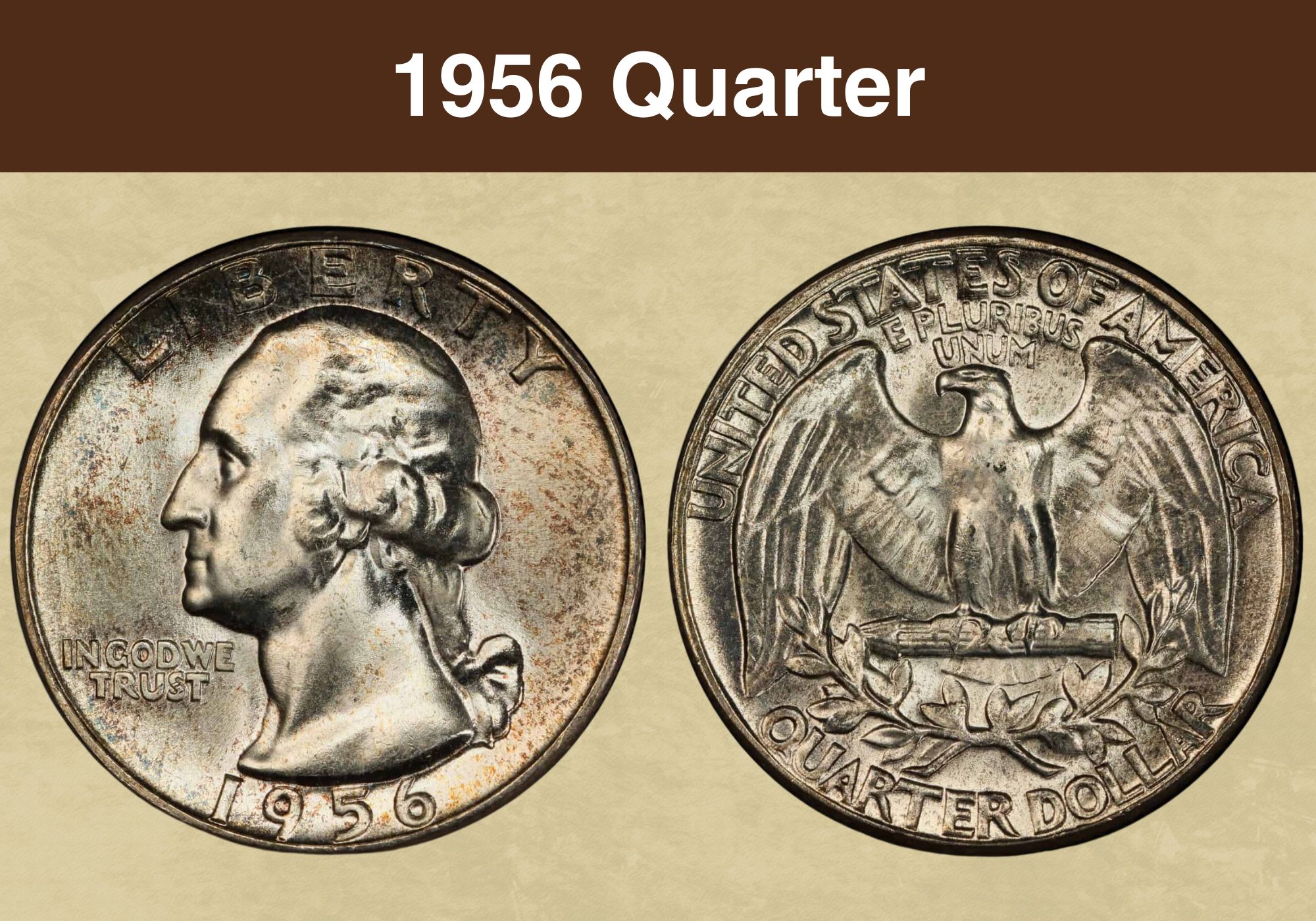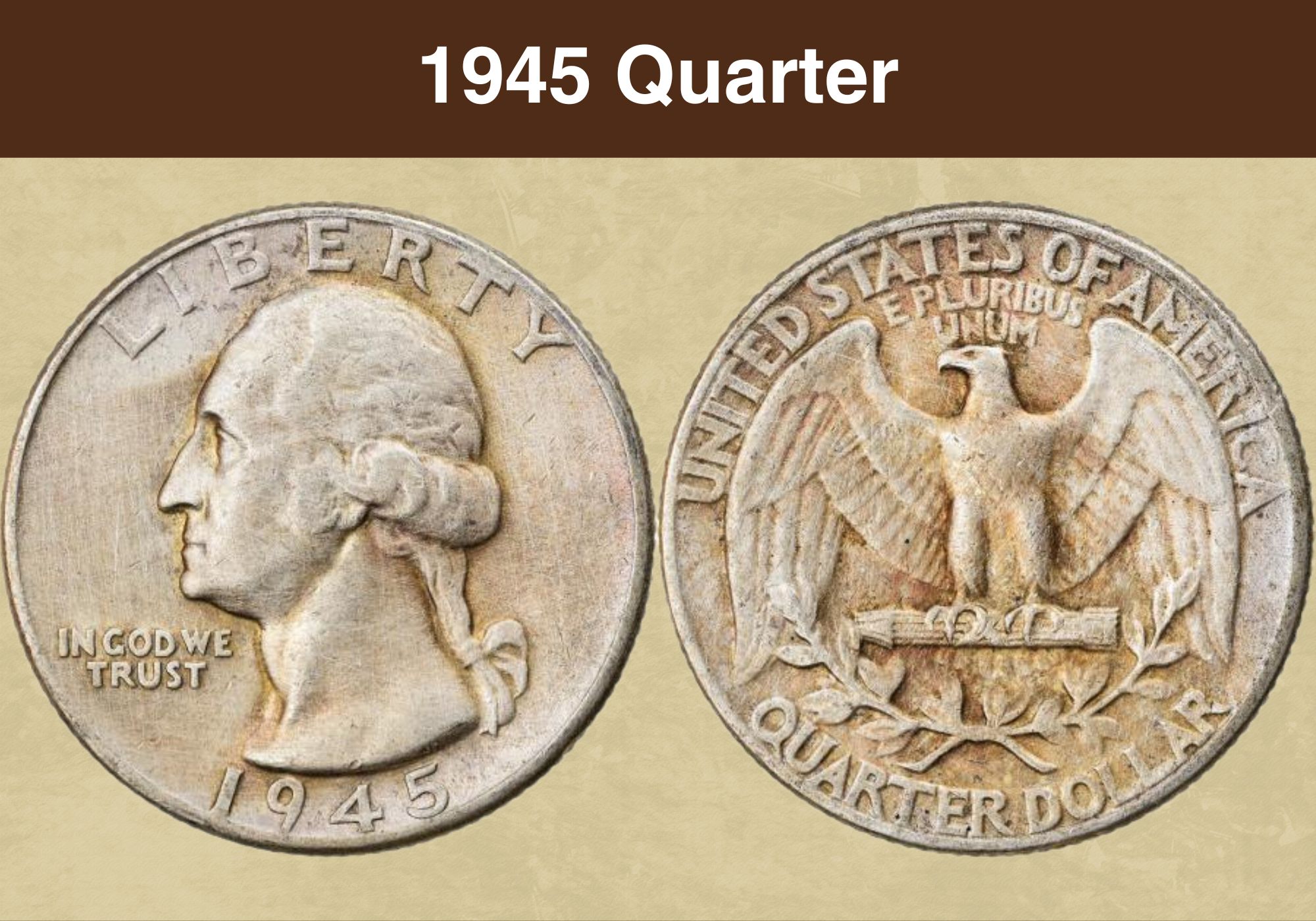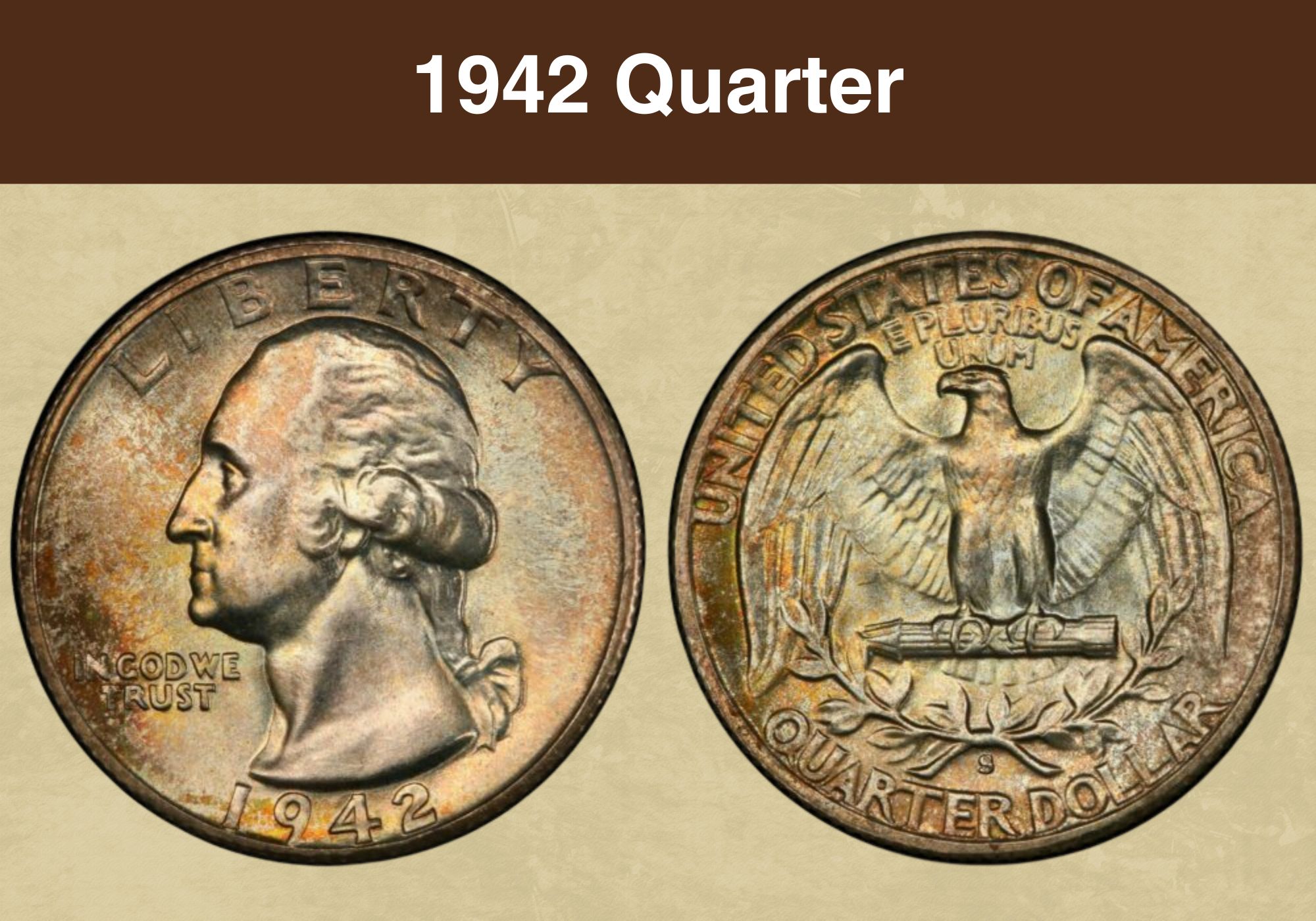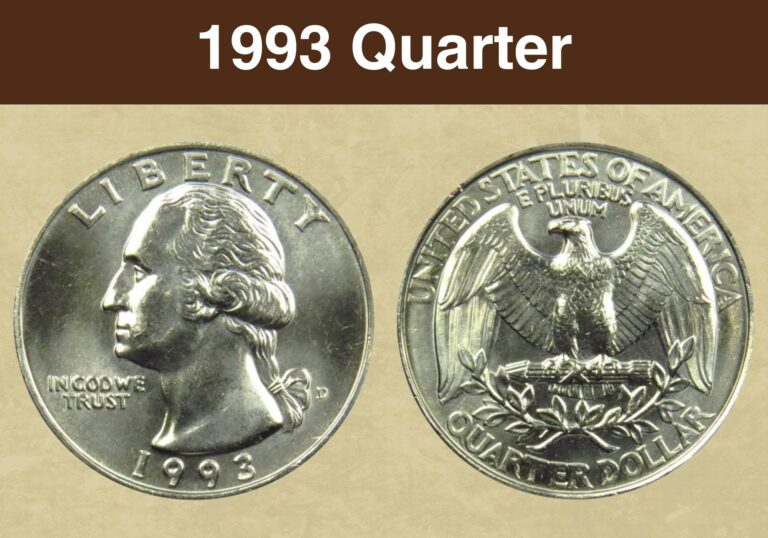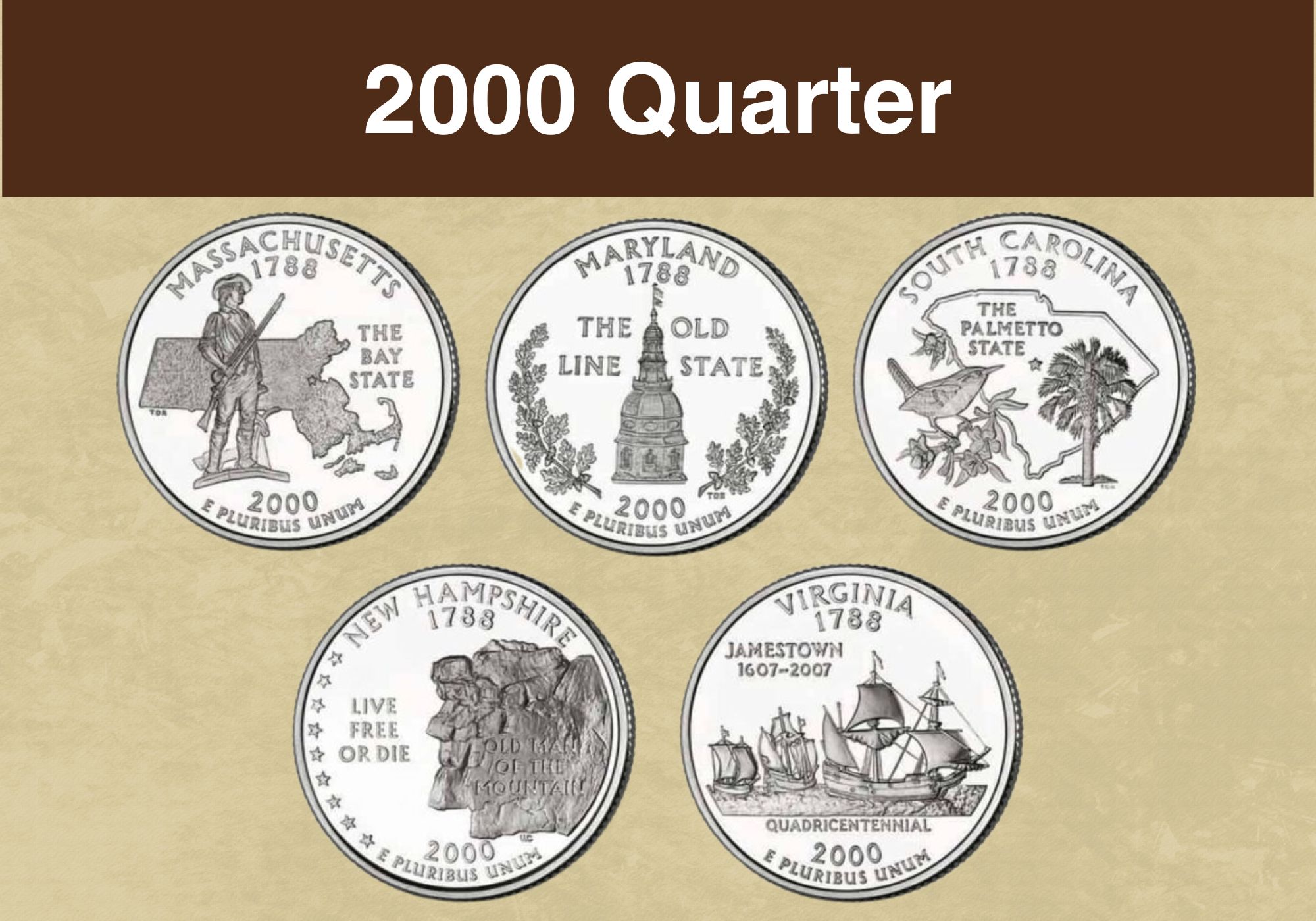
Coin Value Contents Table
Do you have a quarter from the start of the new Millennium? If so, you might be wondering if its interesting date makes it collectible. That’s what we’re about to find out!
We’re going to look at the 2000 quarter value. We’ll look at what separates an average coin from something that’s interesting to collectors. And we’ll learn about the history and design of the quarter along the way.
So if you’re ready to find out what your coin might be worth, let’s get started.
2000 Quarter Value Chart |
||||
| Mint mark | MS60 | MS63 | MS65 | MS68 |
| 2000 P Massachusetts Quarter Value | $3 | $4 | $5 | $60 |
| 2000 D Massachusetts Quarter Value | $3 | $4 | $5 | $325 |
| 2000 P Maryland Quarter Value | $3 | $4 | $5 | $160 |
| 2000 D Maryland Quarter Value | $3 | $4 | $5 | $275 |
| 2000 P South Carolina Quarter Value | $3 | $4 | $5 | $50 |
| 2000 D South Carolina Quarter Value | $3 | $4 | $5 | $110 |
| 2000 P New Hampshire Quarter Value | $3 | $4 | $5 | $160 |
| 2000 D New Hampshire Quarter Value | $3 | $4 | $5 | $400 |
| 2000 P Virginia Quarter Value | $3 | $4 | $5 | $150 |
| 2000 D Virginia Quarter Value | $3 | $4 | $5 | $750 |
| PR60 | PR65 | PR68 | PR70 | |
| 2000 S Massachusetts Proof Quarter Value | $5 | $9 | $12 | $70 |
| 2000 S Maryland Proof Quarter Value | $5 | $9 | $12 | $55 |
| 2000 S South Carolina Proof Quarter Value | $5 | $9 | $12 | $60 |
| 2000 S New Hampshire Proof Quarter Value | $5 | $9 | $12 | $170 |
| 2000 Virginia Proof Quarter Value | $5 | $9 | $12 | $65 |
History of the 2000 Quarter
Five different quarters were issued in the year 2000. They were part of the series known as the 50 States quarters, each of which honored a different US state. The coins had been launched with the express intention of stimulating interest in coin collecting in a new generation.
The idea had been inspired by a program across the border. In 1992, Canada’s launch of its own commemorative coins, issued to mark the 125th anniversary of Confederation, had been wildly successful.
The US version was just the same. It’s estimated that half of all Americans collected the 50 States coins.
The Mint released a coin for each state, issuing one every ten weeks. The program ran from 1999 to 2008, with five states being honored each year. The order was determined by the order in which the states had been admitted to the Union or had ratified the Constitution.
The five quarters issued in 2000 were, in order of release, Massachusetts, Maryland, South Carolina, New Hampshire and Virginia. Quarters clad in cupronickel were issued for everyday use, and silver proof coins were issued as collectors’ pieces too.
As well as being hugely successful in inspiring new collectors, huge numbers of Americans were involved in the process of designing the coins.
Most states held competitions for designs, and seventeen put the shortlist to a public vote. In total, some 3.5 million US citizens took part in some way.
Also read: Top 13 Most Valuable State Quarters Worth Money
Features of the 2000 Quarter
The Obverse of the 2000 Quarter
The obverse of the quarters issued in 2000 look much the same as those from most other years. They carry a portrait of George Washington, the first president of the USA.
It was the work of a sculptor named John Flanagan. But its selection has caused some controversy over the years.
The first quarters bearing Washington’s portrait were released in 1932 to mark the bicentenary of his birth. It had originally been expected that commemorative coins with his image would be a one-off. As such, the choice of a design had been left to a committee overseeing the celebrations.
But it was subsequently decided that Washington should be honored with a permanent coin. And the decision on its design therefore passed to the Treasury.
The Bicentenary Committee, meanwhile, had already chosen a portrait for use on the coin. It was the image of Washington by Laura Gardin Fraser that’s been used on quarters since 2022. But the Treasury Secretary, Andrew W. Mellon, preferred Flanagan’s portrait.
The Committee put up a rearguard action, but to no avail. And from 1932 to 2021, it was Flanagan’s portrait that appeared on the quarter.
Above it, the words “UNITED STATES OF AMERICA” run parallel to the upper coin edge. The word “LIBERTY” appears to the left of the portrait, while the motto “IN GOD WE TRUST” is to the right. The denomination, written as “QUARTER DOLLAR” is at the bottom.
The mint mark is to the right of the coin, just below “IN GOD WE TRUST”. Coins struck in Philadelphia are marked with a “P”, those from Denver with a “D”, and proofs from San Francisco with an “S”.
The Reverse of the 2000 Quarter
The reverse is the side of the coin that has the design for the state. The images cover a wide variety of subjects – maps, symbols, birds, plant, animals, and people.
The Massachusetts quarter shows the statue of The Minute Man, a sculpture in a historical park in Concord. It’s superimposed on an outline of the state, with the caption “THE BAY STATE” to the right.
The Maryland quarter features the elegant dome of the Maryland State House, with two sprigs of white oak, the state tree. Its caption, “THE OLD LINE STATE” is inscribed over two lines on either side of the dome.
For South Carolina, the design incorporates the state flower (yellow jessamine), bird (Carolina wren), and tree (cabbage palmetto). All appear in front of an outline of the state map, with the caption “THE PALMETTO STATE”.
The New Hampshire design shows the Old Man of the Mountain, a rocky crag with the appearance of a face. A caption identifying the image is super-imposed on it. To its left is the state motto, “LIVE FREE OR DIE”.
The final quarter issued in 2000 was for Virginia.
Its design features three ships, the Godspeed, the Susan Constant, and the Discovery. To the left is inscribed “JAMESTOWN, 1607-2007” and beneath the image, “QUADRICENTENNIAL”. Both refer to the foundation of Jamestown, the first permanent English-speaking settlement in the US.
Other Features of the 2000 Quarter
The quarters issued for everyday use in 2000 were made with a copper core clad in cupronickel. It is the nickel content of this cladding which gives these quarters their silver color.
All the quarters issued in Philadelphia and Denver are clad coins. They measure 24.3 millimeters in diameter and weigh 5.67 grams.
The proofs struck in San Francisco, however, are made of 90 per cent silver and 10 per cent copper. They have the same dimensions but weigh slightly more – 6.3 grams.
This YouTube video from DC Coin World shows the Massachusetts and New Hampshire 2000 quarters in detail.
2000 Quarter Grading
| # | Grade |
|---|---|
| 1 | Basal State-1 |
| 2 | Fair |
| 3 | Very Fair |
| 4, 5, 6 | Good |
| 7, 8, 10 | Very Good |
| 12, 15 | Fine |
| 20, 30 | Very Fine |
| 40 | Extremely Fine |
| 50 | About Uncirculated |
| 60 | Mint State |
| 65 | Mint State |
| 70 | Mint State |
Please check our grading guides to know your coin scale, It’s the necessary step to know the exact value of your coin.
Check out now: How to Grade Washington Quarter?
2000 Quarter Value Guides
2000 P Quarter Value
Vast quantities of quarters were struck in Philadelphia in 2000. With the first 50 States quarters having been issued only the previous year, demand for the coins was high.
Almost 630 million Massachusetts quarters were struck. The figures for Maryland were almost 680 million, for South Carolina over 740 million, for New Hampshire over 670 million, and for Virginia over 940 million.
The huge mintages mean that coins in circulated condition are generally worth only their face value. The exception to this is if a coin has an interesting Mint error.
In mint state, coins are generally worth a few dollars. Regardless of the state it honors, a coin at the lowest mint state grade, MS60, will be worth around $3. That rises gradually to $4 at MS63 and $5 at MS65, the lowest grade at which a coin is termed a “gem”.
The only difference in values between the states comes at the very highest grades. At MS68 and above, however, those differences can be significant.
A Massachusetts quarter graded MS68 is worth only around $60. But a Virginia quarter at the same grade is worth $150.
The difference is explained by availability, and by whether the coins are “best in class”.
The independent coin grading agency, the PCGS, has certified 149 2000-P Virginia quarters at MS68, with none finer.
But the 2000-P Massachusetts quarter is available in grades right up to MS69. The sole coin to have been graded MS68+ to date is valued at $400. And the two MS69 examples are each worth an impressive $7,000.
2000 D Quarter Value
It’s a similar story for the 2000 quarters struck in Denver.
Mintages were again high, though not quite as high as for the Philadelphia equivalents. 535 million Massachusetts quarters, 557 million Maryland, 566 million South Carolina, 496 million New Hampshire and 652 million Virginia quarters were struck.
Coins in circulated condition will be worth less than a dollar unless they have an interesting Mint error. And in uncirculated condition, values range from $3 to $5 between MS60 and MS65.
It’s not until MS67 that the values of the different state quarters diverge. A South Carolina 2000-D quarter at that grade is valued at $18, while the Virginia and New Hampshire equivalents are worth $18 and $40 respectively.
The most valuable coins are those that are the finest examples of their type.
For all the 2000-D state quarters except Massachusetts, the top grade is MS68. The values of those range from $110 for South Carolina (156 quarters certified to date by the PCGS), through to $750 for Virginia (just 17 certified coins).
The forty 2000-D Massachusetts quarters graded at the same level by the PCGS are worth $325 apiece. But half a point higher, that value rises to $925. And to date, one coin has been certified at MS69 and is valued at $9,000.
2000 S Proof Quarter Value
The silver proofs struck at the San Francisco Mint facility can be readily identified by the “S” on the obverse. The same number were struck for each state – 965,421.
Proofs are, by definition, uncirculated. And despite being high quality coins, the fact that they were always marketed as collectors’ items means they’re still easy to find. That keeps the value of proofs at most grades surprisingly modest.
A proof 2000 quarter commemorating any state will be worth around $5 at PR60. At PR68, the value is only around $12. And a near-perfect PR69 is worth around $22.
The availability of the different designs does, however, vary at PR70.
For a Massachusetts proof, a perfect PR70 coin is worth $70. The figure is $55 for Maryland, $60 for South Carolina, $170 for New Hampshire, and $65 for Virginia.
Also read: Top 16 Most Valuable Modern Quarters Worth Money
Rare 2000 Quarter Errors List
2000 P Massachusetts Quarter, Struck Off-Center
Finding Mint errors amongst modern coins can be challenging – but things do still go wrong.
Occasionally, the planchet and die aren’t properly aligned, resulting in the coin being struck off-center. The further off-center the strike, the more it will generally be worth to collectors. And just as with non-error coins, condition will be key to value too.
One 2000 Massachusetts quarter produced in Philadelphia was struck 25 per cent off-center. It was graded MS64 by the coin grading agency, the NGC. And it sold at auction for $100.
2000 D Virginia Quarter, Double Struck and Struck Off-Center
Sometimes, coins combine more than one type of error. That was the case for one Virginia quarter, struck in Denver in 2000.
It was not ejected as it should have been after striking, and was struck a second time. The second strike was also off-center, creating a very strange-looking coin.
It was graded MS64 by the PCGS. And when it came up for auction, it sold for over $700.
You can see both these error coins, and more, in detail in this YouTube video from Couch Collectibles.
Also read: 17 Most Valuable Quarter Errors Worth Money
Where to Sell Your 2000 Quarter ?
Now that you know the value of your coins, do you know where to sell those coins online easily? Don’t worry, I’ve compiled a list of these sites, including their introduction, pros, and cons.
Check out now: Best Places To Sell Coins Online (Pros & Cons)
FAQs
What is the most valuable 2000 quarter?
The most valuable non-error quarter issued in 2000 is the top quality Massachusetts quarter struck in Denver. It’s graded MS69, one point away from perfect. And that also makes it a higher grade than any other 2000 state quarter.
The PCGS values that coin today at $9,000.
What was the most valuable quarter in the 2000’s?
That prize goes to a coin that isn’t really a quarter at all. It’s the first authentic example of a mule – an error coin with an obverse and reverse that should never have been seen together.
It was discovered in 2000, and combined the obverse of a 2000 Washington quarter with the reverse of a Sacagawea dollar. Since then, a handful of other examples of the same mule have come to light.
They range in quality from MS63 to MS67. The MS63 example is valued by the PCGS at $43,500. And the MS67 is worth a cool $200,000.

